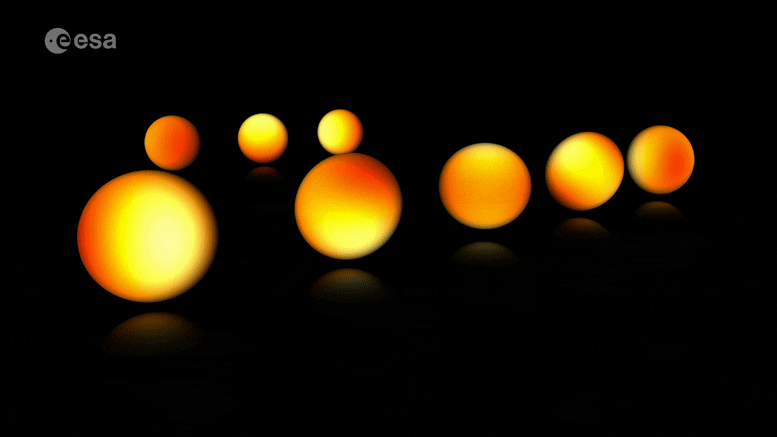

Un descubrimiento sorprendente que surge de la publicación de datos de Gaia 3 es que Gaia puede detectar terremotos estelares (pequeños movimientos en la superficie de una estrella) que cambian las formas de las estrellas, algo para lo que el observatorio no se construyó originalmente. Crédito: ESA/Gaia/DPAC, CC BY-SA 3.0 IGO
Gaia es la misión de la Agencia Espacial Europea (ESA) para crear un mapa 3D preciso de más de mil millones de estrellas en todo[{” attribute=””>Milky Way galaxy and beyond. Although it launched all the way back in 2013, it is still working to accurately map the the motions, luminosity, temperature and composition of the stars in our galaxy.
Along the way it has made numerous discoveries, such as detecting a shake in the Milky Way, the observation of almost 500 explosions in galaxy cores, crystallization in white dwarfs, and discovering a billion-year-old river of stars. It also revealed the total weight of the Milky Way, a direct measurement of the galactic bar in the Milky Way, mysterious fossil spiral arms in the Milky Way, and a new member of the Milky Way family.
Today marks the data of the third data release from Gaia. The first data release was on September 14, 2016, followed by the second data release on April 25, 2018. On December 3, 2020, they did an early third data release with detailed data on more than 1.8 billion stars. All this data is helping to reveal the origin, structure, and evolutionary history of our galaxy.

This image shows four sky maps made with the new ESA Gaia data released on June 13, 2022. Credit: © ESA/Gaia/DPAC; CC BY-SA 3.0 IGO
Today (June 13, 2022), ESA’s Gaia mission releases its new treasure trove of data about our home galaxy. Astronomers describe strange ‘starquakes’, stellar DNA, asymmetric motions, and other fascinating insights in this most detailed Milky Way survey to date.
Gaia is ESA’s mission to create the most accurate and complete multi-dimensional map of the Milky Way. This allows astronomers to reconstruct our home galaxy’s structure and past evolution over billions of years, and to better understand the lifecycle of stars and our place in the Universe.
¿Qué hay de nuevo en la versión de datos 3?
La publicación de datos de Gaia 3 contiene detalles nuevos y mejorados de casi dos mil millones de estrellas en nuestra galaxia. El catálogo incluye nueva información que incluye composiciones quimicastemperaturas estelares, colores, masas, edades y la velocidad con la que las estrellas se acercan o se alejan de nosotros (velocidad radial). Gran parte de esta información fue revelada por el recién publicado Espectroscopia Datos, una tecnología en la que la luz de las estrellas se divide en sus colores componentes (como un arcoíris). Los datos también incluyen subconjuntos especiales de estrellas, como aquellas que cambian de brillo con el tiempo.
Otra novedad en este conjunto de datos es el catálogo más grande hasta la fecha de estrellas binarias, miles de objetos del Sistema Solar, como asteroides y lunas planetarias, y millones de galaxias y cuásares fuera de la Vía Láctea.
temblores
Uno de los descubrimientos más sorprendentes que surgen de los nuevos datos es que Gaia puede detectar terremotos estelares (pequeños movimientos en la superficie de una estrella) que cambian la forma de las estrellas, algo para lo que el observatorio no se construyó originalmente.
Anteriormente, Gaia ya había encontrado oscilaciones radiales que hacen que las estrellas se hinchen y se contraigan periódicamente, manteniendo su forma esférica. Pero Gaya ahora también ha detectado otras vibraciones que se asemejan mucho a un tsunami a gran escala. Estas oscilaciones no radiales alteran la forma global de la estrella y, por lo tanto, son difíciles de detectar.
Gaia ha encontrado fuertes terremotos no radiales en miles de estrellas. Gaia también detectó tales vibraciones en estrellas que rara vez se habían visto antes. Estas estrellas no deberían tener ningún terremoto según la teoría actual, mientras que Gaia los detectó en su superficie.
“Los terremotos nos enseñan mucho sobre las estrellas, especialmente sobre su funcionamiento interno. Gaia abre una mina de oro para la ciencia estelar masiva”, dice Connie Aerts de KU Leuven en Bélgica, miembro de Gaya Collaboration.
ADN estelar
El material del que están hechas las estrellas puede decirnos dónde nacieron y su próximo viaje y, por lo tanto, sobre la historia de la Vía Láctea. Con la publicación de datos hoy, Gaia revela el mapa químico más grande de la galaxia junto con movimientos en 3D, desde nuestro vecindario solar hasta las galaxias más pequeñas que nos rodean.
Algunas estrellas contienen más “metales pesados” que otras. durante el[{” attribute=””>Big Bang, only light elements were formed (hydrogen and helium). All other heavier elements – called metals by astronomers – are built inside stars. When stars die, they release these metals into the gas and dust between the stars called the interstellar medium, out of which new stars form. Active star formation and death will lead to an environment that is richer in metals. Therefore, a star’s chemical composition is a bit like its DNA, giving us crucial information about its origin.

This image shows an artistic impression of the Milky Way, and on top of that an overlay showing the location and densities of a young star sample from Gaia’s data release 3 (in yellow-green). The “you are here” sign points towards the Sun. Credit: © ESA/Gaia/DPAC; CC BY-SA 3.0 IGO
With Gaia, we see that some stars in our galaxy are made of primordial material, while others like our Sun are made of matter enriched by previous generations of stars. Stars that are closer to the center and plane of our galaxy are richer in metals than stars at larger distances. Gaia also identified stars that originally came from different galaxies than our own, based on their chemical composition.
“Our galaxy is a beautiful melting pot of stars,” says Alejandra Recio-Blanco of the Observatoire de la Côte d’Azur in France, who is a member of the Gaia collaboration.
“This diversity is extremely important, because it tells us the story of our galaxy’s formation. It reveals the processes of migration within our galaxy and accretion from external galaxies. It also clearly shows that our Sun, and we, all belong to an ever-changing system, formed thanks to the assembly of stars and gas of different origins.”

This image shows the orbits of the more than 150,000 asteroids in Gaia’s data release 3, from the inner parts of the Solar System to the Trojan asteroids at the distance of Jupiter, with different color codes. The yellow circle at the center represents the Sun. Blue represents the inner part of the Solar System, where the Near Earth Asteroids, Mars crossers, and terrestrial planets are. The Main Belt, between Mars and Jupiter, is green. Jupiter trojans are red. Credit: © ESA/Gaia/DPAC; CC BY-SA 3.0 IGO, Acknowledgements: P. Tanga (Observatoire de la Côte d’Azur)
Binary stars, asteroids, quasars, and more
Other papers that are published today reflect the breadth and depth of Gaia’s discovery potential. A new binary star catalog presents the mass and evolution of more than 800 thousand binary systems, while a new asteroid survey comprising 156 thousand rocky bodies is digging deeper into the origin of our Solar System. Gaia is also revealing information about 10 million variable stars, mysterious macro-molecules between stars, as well as quasars and galaxies beyond our own cosmic neighborhood.

The position of each asteroid at 12:00 CEST on June 13, 2022, is plotted. Each asteroid is a segment representing its motion over 10 days. Inner bodies move faster around the Sun (yellow circle at the center). Blue represents the inner part of the Solar System, where the Near Earth Asteroids, Mars crossers, and terrestrial planets are. The Main Belt, between Mars and Jupiter, is green. The two orange ‘clouds’ correspond to the Trojan asteroids of Jupiter. Credit: © ESA/Gaia/DPAC; CC BY-SA 3.0 IGO, Acknowledgements: P. Tanga (Observatoire de la Côte d’Azur)
“Unlike other missions that target specific objects, Gaia is a survey mission. This means that while surveying the entire sky with billions of stars multiple times, Gaia is bound to make discoveries that other more dedicated missions would miss. This is one of its strengths, and we can’t wait for the astronomy community to dive into our new data to find out even more about our galaxy and its surroundings than we could’ve imagined,” says Timo Prusti, Project Scientist for Gaia at ESA.

“Futuro ídolo adolescente. Explorador amigable. Alborotador. Especialista en música. Practicante ávido de las redes sociales. Solucionador de problemas”.





More Stories
Compensar el sueño los fines de semana puede reducir el riesgo de enfermedad cardíaca en una quinta parte: estudio | Cardiopatía
¿Cómo se hicieron los agujeros negros tan grandes y rápidos? La respuesta está en la oscuridad.
Una estudiante de la Universidad de Carolina del Norte se convertirá en la mujer más joven en cruzar las fronteras del espacio a bordo de Blue Origin